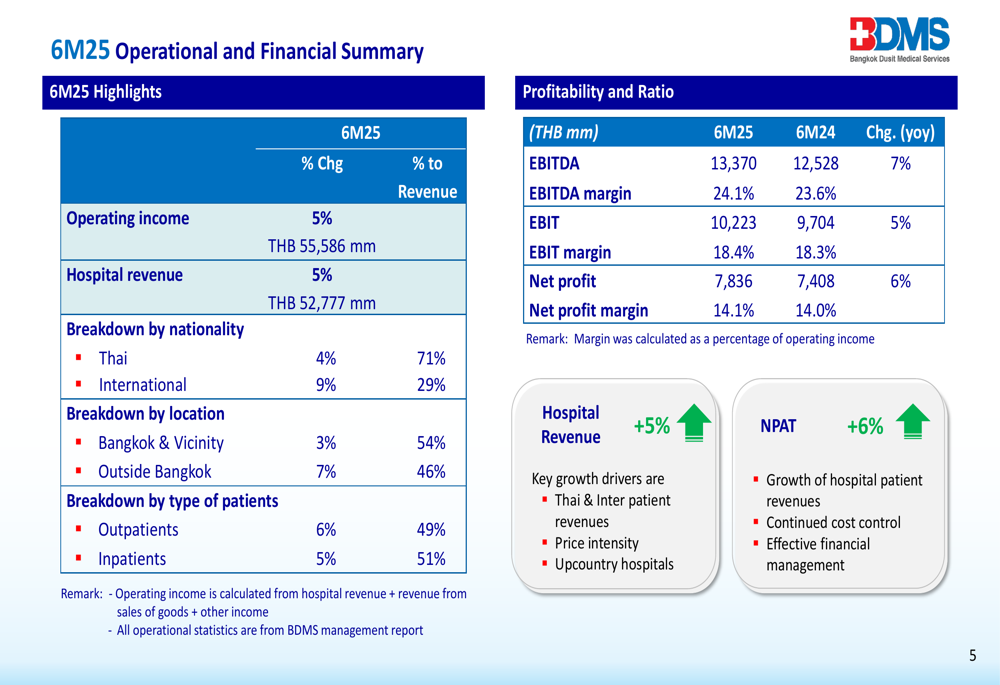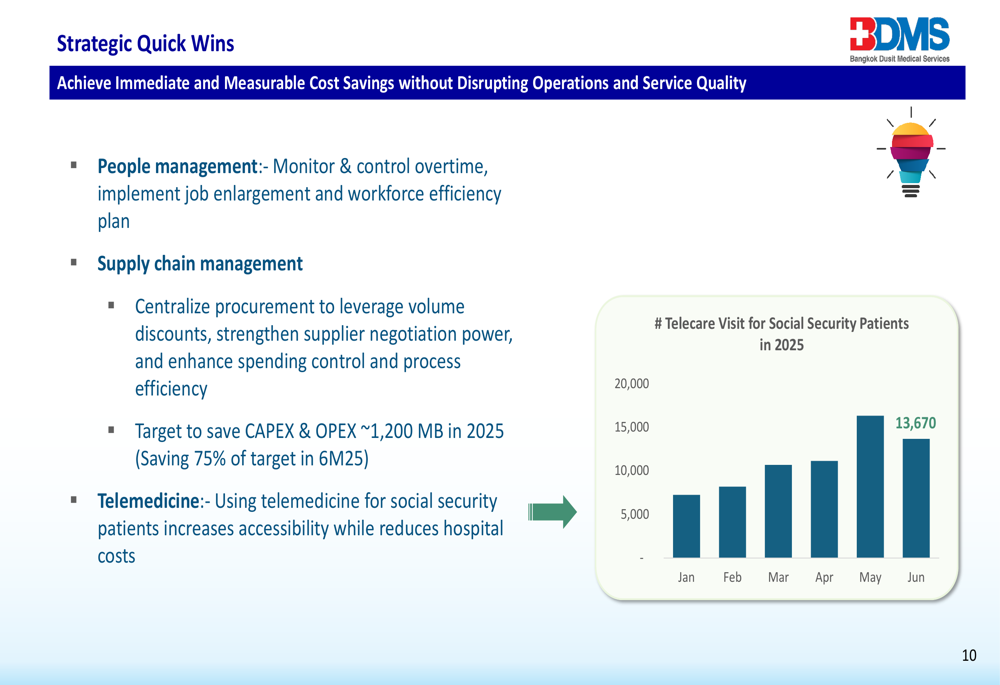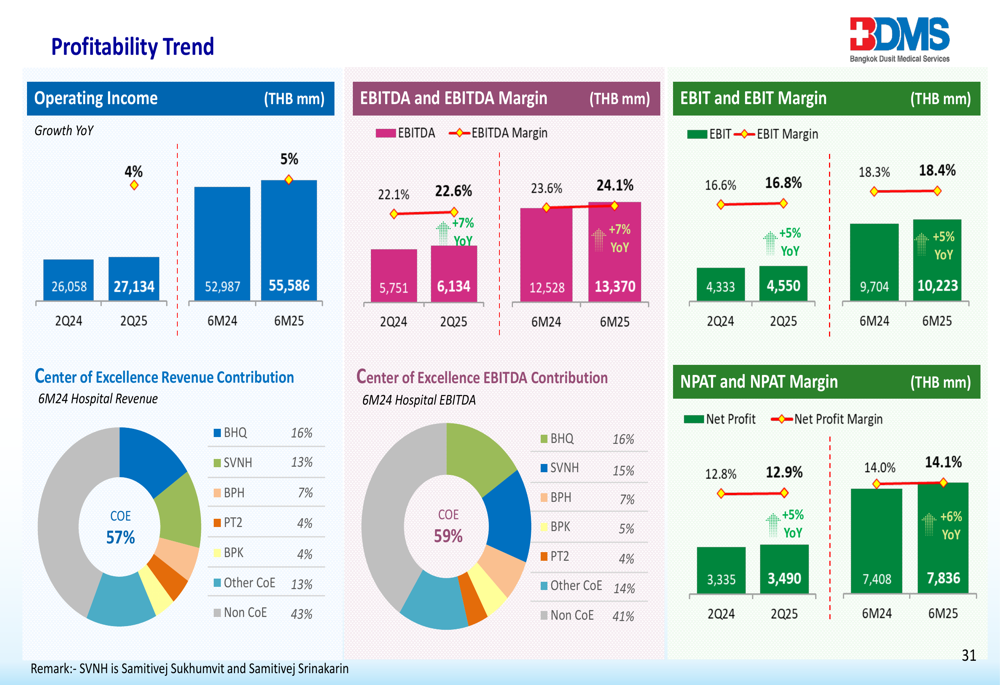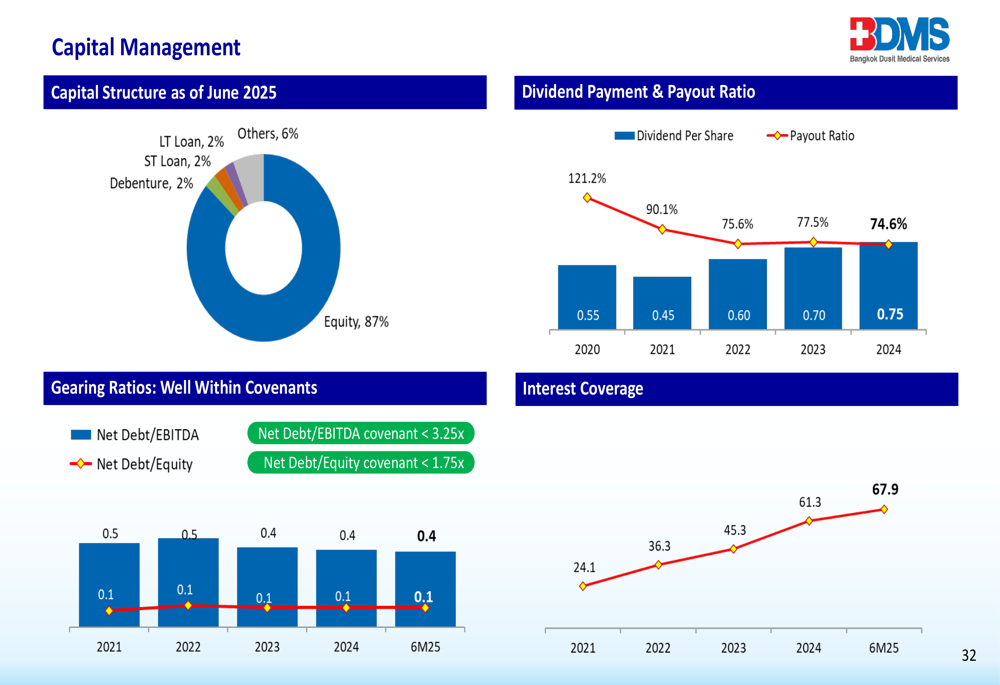Michigan survey ahead; Applied Digital surges; gold dips - what’s moving markets
Introduction & Market Context
Bangkok Dusit Medical Services PCL (BDMS) presented its second quarter and first half 2025 results on August 14, 2025, showing steady growth across key financial metrics despite some regional challenges. The healthcare provider, which operates a network of hospitals across Thailand and Southeast Asia, continues to benefit from its strategic focus on Centers of Excellence and international patient growth.
The company’s stock closed at 21.7 on August 15, 2025, down 2.76% following the presentation, suggesting investors may have expected stronger results or were concerned about specific challenges mentioned during the presentation.
Quarterly Performance Highlights
BDMS reported a 4% year-over-year increase in operating income to THB 27,134 million for Q2 2025, while hospital revenue grew by 4% to THB 25,699 million. The company’s profitability metrics showed solid improvement, with EBITDA rising 7% to THB 6,134 million (22.6% margin), EBIT increasing 5% to THB 4,550 million (16.8% margin), and net profit growing 5% to THB 3,490 million (12.9% margin).
As shown in the following comprehensive financial overview for the first half of 2025:

For the first half of 2025, BDMS achieved a 5% increase in operating income to THB 55,586 million, while hospital revenue grew 5% to THB 52,777 million. The company’s EBITDA rose 7% to THB 13,370 million with a margin of 24.1%, while net profit increased 6% to THB 7,836 million with a margin of 14.1%.
Revenue growth was driven by both Thai patients (4% growth, 71% of total) and international patients (9% growth, 29% of total). Geographically, Bangkok and vicinity contributed 54% of revenue with 3% growth, while hospitals outside Bangkok accounted for 46% with stronger growth of 7%.
International Patient Growth
The company’s international patient segment showed strong performance in the first half of 2025, with overall revenue growth of 9% year-over-year. This growth was led by patients from Qatar (+50%), Myanmar (+21%), USA (+17%), and UK (+15%).
The following breakdown shows the top nationalities contributing to BDMS’s international revenue:

However, the presentation highlighted a significant challenge with Cambodian patients, showing a 12% decline in revenue from this previously top-contributing nationality. Management attributed this decrease to ongoing border disputes between Thailand and Cambodia, which affected patient flow particularly in July 2025.
The company’s geographic diversification strategy appears to be paying off, with strong growth in tourist destinations such as Chiangmai (18% YoY), Rayong (9% YoY), and Phuket (7% YoY), helping to offset challenges in other markets.
Strategic Initiatives
BDMS outlined several strategic initiatives aimed at boosting top-line growth while achieving cost savings. The company is expanding its network of outreach clinics in high-traffic areas, with over 70 clinics now operational (20+ in Bangkok and 50+ outside Bangkok). These clinics focus on social security and insurance patients, helping to expand the patient base while controlling costs.
The company is also recruiting more specialist doctors at its Centers of Excellence, launching inclusive medical packages, and strengthening collaborations with insurance companies. The insurance payor contribution has already increased from 31% in 2019 to 38% in the first half of 2025, indicating success in this strategic direction.
On the cost management front, BDMS is implementing several initiatives:

The company is targeting approximately THB 1,200 million in CAPEX and OPEX savings in 2025 through centralized procurement and enhanced spending control. Additionally, telemedicine services for social security patients are showing increasing adoption, with 13,670 telecare visits recorded in June 2025 alone.
Centers of Excellence Performance
BDMS’s Centers of Excellence (COE) strategy continues to be a key driver of growth, contributing 57% of hospital revenue in the first half of 2025. The COE segment grew 4% year-over-year, led by Bangkok Hospital Headquarters (+5%), Bangkok Hospital Chiangmai (+18%), and Bangkok Hospital Phuket (+6%).
The company’s specialty hospitals are showing particularly strong performance, with the Cancer Hospital (WSH) growing 12% and the Brain & Bone Hospital (BIH) growing an impressive 24% year-to-date through July 2025.
BDMS is also making significant investments in advanced medical technologies, particularly in robotic surgery. The BDMS Robotic Center has completed over 600 cases, and the company is positioning itself as a robotic hub for surgery in the Asia-Pacific region.
The following roadmap illustrates BDMS’s strategic vision for its Centers of Excellence:

Key initiatives include becoming the robotic hub for surgery in Asia-Pacific, offering the first minimally invasive heart surgery at a private hospital in Thailand, developing Geno Life Services, planning for proton therapy by 2029, establishing a new world-class rehabilitation hospital in partnership with Abilitylab, and positioning as a Medevac Center for Asia.
Financial Position and Outlook
BDMS maintains a strong financial position with well-managed debt levels and solid profitability metrics. The company’s profitability trends show consistent improvement across key metrics:

The company’s capital structure remains robust, with a well-balanced mix of long-term loans, short-term loans, debentures, and equity. Dividend payments have been consistent, and gearing ratios remain well within covenant requirements:

Looking ahead, BDMS expects continued growth driven by its Centers of Excellence, international patient recovery (particularly from China, USA, and Middle Eastern countries), and expansion of outreach clinics. However, management noted potential challenges including the ongoing border dispute with Cambodia and the high base effect from the influenza epidemic in 2024, which may impact year-over-year comparisons in the coming months.
The company’s strategic focus on specialty centers, technological advancement, and geographic diversification positions it well for sustainable growth in the competitive healthcare landscape of Southeast Asia.
Full presentation:
This article was generated with the support of AI and reviewed by an editor. For more information see our T&C.
